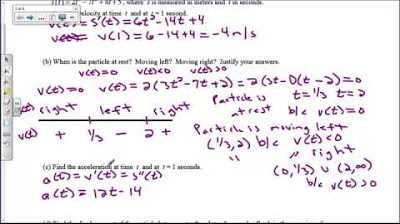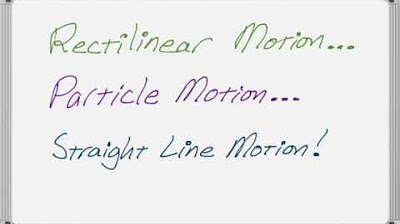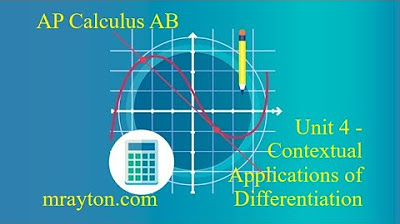Particle Motion Day 2
TLDRIn this educational video, the host explores particle motion, focusing on the relationship between velocity, acceleration, and position. They use a cubic function to represent the position of a particle moving horizontally and graph it to determine the intervals of motion direction. The video also covers calculating distance traveled and identifying intervals of increasing speed, using calculus concepts and a calculator for precise calculations.
Takeaways
- 📚 The video is a lesson on particle motion, focusing on concepts such as velocity, acceleration, and position, and how they are interrelated.
- 📈 The position of the particle is described by a cubic function, and the velocity is determined by taking the first derivative of this position function.
- 📊 The velocity function is graphed to find when the particle is moving to the right (above the x-axis) and when it is moving to the left (below the x-axis).
- 🔍 The zeros of the velocity function are found using a calculator to determine the intervals of motion direction changes.
- 🚀 The particle moves to the right on the interval from 0 to approximately 0.137 and from approximately 3.11963 to infinity, and to the left from approximately 0.137 to 3.11963.
- 📝 To find the distance traveled by the particle, the positions at specific times are calculated and the absolute values of the movements are summed up.
- 🔢 The total distance traveled by the particle from 0 to 5 is found by adding the movements in the positive direction.
- 📉 The intervals where the speed is increasing are determined by when both velocity and acceleration have the same sign, indicating they are working together.
- 📈 The acceleration function is graphed alongside the velocity function to visually determine the intervals of increasing speed.
- ✏️ An example from the AP Calculus exam is used to demonstrate how to find the acceleration of a particle at a specific time by evaluating the derivative of the velocity function.
- 🔧 The use of a calculator is emphasized throughout the lesson for solving complex problems that cannot be easily done by hand.
Q & A
What are the relationships being discussed in the script between speed, velocity, acceleration, and position?
-The script discusses how speed, velocity, acceleration, and position are related in the context of particle motion. Speed is the magnitude of velocity, which is a vector quantity that includes both speed and direction. Acceleration is the rate of change of velocity, and position is the location of the particle in space, which can be described by a function of time.
What is the purpose of using a calculator in the context of this script?
-The calculator is used to solve complex mathematical problems that cannot be easily done by hand, such as finding the zeros of a velocity function, evaluating derivatives for acceleration, and calculating the distance traveled by a particle over a given time interval.
How is the position of the particle described in the script?
-The position of the particle is described by a cubic function of time, which is then differentiated to find the velocity and acceleration of the particle.
What is the significance of the velocity function being above or below the x-axis in the context of the particle's motion?
-If the velocity function is above the x-axis, it indicates that the particle is moving to the right, and if it is below the x-axis, it indicates that the particle is moving to the left.
How does the script determine the intervals where the particle is moving right or left?
-The script determines the intervals by analyzing the sign of the velocity function. When the velocity is positive (above the x-axis), the particle is moving right, and when it is negative (below the x-axis), the particle is moving left.
What is the method used to find the distance traveled by the particle from 0 to 5?
-The method involves calculating the position of the particle at different time intervals and then summing the absolute values of the differences to find the total distance traveled.
How does the script find the zeros of the velocity function?
-The script uses the calculator's 'math zero' function to find the zeros of the velocity function, which are the points where the particle changes direction.
What is the relationship between velocity and acceleration when determining if the speed is increasing or decreasing?
-The speed is increasing when both velocity and acceleration have the same sign, indicating they are working together. The speed is decreasing when they have different signs, indicating they are working against each other.
How does the script calculate the acceleration of the particle at a specific time?
-The script calculates the acceleration by finding the derivative of the velocity function with respect to time and then evaluating this derivative at the specific time of interest, in this case, t equals four.
What is the significance of the critical point at 3.11963 in the context of the particle's motion?
-The critical point at 3.11963 is significant because it is a zero of the velocity function, indicating a change in the direction of the particle's motion. After this point, both velocity and acceleration are positive, meaning the particle is moving to the right and speeding up.
Outlines
🔍 Understanding Particle Motion Concepts
This paragraph introduces the topic of particle motion, explaining the relationship between velocity, acceleration, position, and speed. It emphasizes the use of a calculator to solve related problems and describes a particle moving along a horizontal line. The position is given by a cubic function, and the task is to determine when the particle is moving right or left, which involves analyzing the velocity equation, a derivative of the position equation. The process involves graphing the velocity to identify when it is above (moving right) or below (moving left) the x-axis.
📊 Analyzing Velocity Graphs with Calculators
In this paragraph, the focus is on graphing the velocity function using a calculator. The steps to check and uncheck functions, graph the velocity, and find the zeros of the quadratic velocity equation are detailed. The zeros indicate the points where the particle changes direction. The intervals during which the particle is moving right or left are identified by analyzing when the velocity is above or below the x-axis. The results show the particle moving right from 0 to approximately 0.2137 and from approximately 3.11963 to infinity, and moving left between these intervals.
🔢 Calculating Distance Traveled
This section explains how to calculate the total distance traveled by the particle from t = 0 to t = 5. It involves determining the position of the particle at specific times, including when it changes direction. The distances moved in each segment are found by taking the absolute value of the differences in position. Summing these distances gives the total distance traveled, which is approximately 34.638 units. The process involves using the position equation and a calculator to obtain precise values.
📈 Identifying Speed Changes
The paragraph focuses on finding intervals where the speed of the particle is increasing. This requires the velocity and acceleration to have the same sign, meaning they are either both positive or both negative. By graphing both the velocity and acceleration functions, the intervals where they share the same sign are identified. The speed is increasing from approximately 0.2137 to 5/3 and from approximately 3.11963 to infinity. If the question asked about decreasing speed, intervals with different signs would be considered.
📝 Solving AP Calculus Questions
The final paragraph walks through solving a multiple-choice question from the AP Calculus exam. It involves finding the acceleration of a particle at a specific time given its velocity function. The acceleration is the derivative of the velocity, evaluated at the given time. Using a calculator, the derivative of the velocity function is found and evaluated at t = 4, yielding the acceleration value. The detailed steps on using the calculator for this calculation are provided, ensuring accuracy in the result.
Mindmap
Keywords
💡Particle
💡Velocity
💡Acceleration
💡Position
💡Speed
💡Cubic Function
💡Derivative
💡Graphing
💡Calculator
💡Distance Traveled
💡AP Calculus Exam
Highlights
Introduction to particle motion, velocity, acceleration, and position in a horizontal line.
The importance of using a calculator to solve complex particle motion problems.
The relationship between position, velocity, and acceleration in particle motion.
Derivation of the velocity equation from the position equation.
Graphical representation of the velocity function using a calculator.
Finding zeros of the velocity function to determine intervals of motion direction.
Interpretation of the velocity graph to determine when the particle is moving left or right.
Calculation of the distance traveled by the particle using the position function.
Identification of intervals where the particle's speed is increasing based on the signs of velocity and acceleration.
Explanation of how to determine when speed is decreasing by analyzing the signs of velocity and acceleration.
Demonstration of using a calculator to find the acceleration of a particle at a specific time.
The process of differentiating the velocity function to find acceleration.
Evaluating the differentiated function to find acceleration at a given time.
Correction of a mistake during the differentiation process in the calculator.
Final calculation of the acceleration value at time T equals four.
Conclusion and anticipation of further discussion in the next session.
Transcripts
5.0 / 5 (0 votes)
Thanks for rating:





